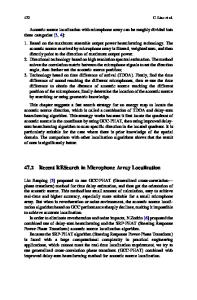A New Bias Method for Microbolometer Array
- PDF / 256,764 Bytes
- 11 Pages / 439.37 x 666.142 pts Page_size
- 84 Downloads / 399 Views
A New Bias Method for Microbolometer Array Xi-qu Chen & Xin-jian Yi
Received: 1 June 2009 / Accepted: 1 September 2009 / Published online: 11 September 2009 # Springer Science + Business Media, LLC 2009
Abstract In this paper, we describe the effect on the performance of focal plane arrays (FPAs) acted by the non-uniformity of microbolometer array resistance under conventional bias methods, put forward a new bias method for the first time, which provides a unique bias to each of microbolometer array detector elements and can be called constant power bias method, deduce the theoretically algorithmic base of this bias method, and verify its advantages. Theoretical analysis and experimentally measuring results indicate that the bias method can effectively improve the performance of microbolometric FPAs. Keywords Bias method . Microbolometer . FPA
1 Introduction With the improvement of fabricating processing for microbolometric arrays and the advance of integrated circuit technology, microbolometric FPAs have been rapidly developed and widely applied [1, 2]. Although current performance of microbolometric FPAs is adequate for many applications such as surveillance and unmanned sensors, improvements are still required in the areas of noise, power dissipation and size. One of the present requirements is to achieve the uniformity characteristics for microbolometric array elements. The nonuniformity characteristics of microbolometric array elements cause most of the noise in microbolometric FPA, which can degrade the image system based on this kind of microbolometric FPA [3, 4], and is driven by a principal factor, the variations in the resistance values from element to element [5]. X.-q. Chen (*) Department of Mathematics and Physics, Wuhan Polytechnic University, Wuhan 430023, China e-mail: [email protected] X.-j. Yi Wuhan National Laboratory for Optoelectronics, Wuhan 430074, China X.-j. Yi State Key Laboratory for Imagine Processing and Intelligent Control, HUST, Wuhan 430074, China
J Infrared Milli Terahz Waves (2010) 31:132–142
133
Under conventional bias methods including constant voltage bias method and constant current bias method, each element in a certain microbolometer array operates at a unique temperature and at a unique location on its nonlinear resistance-temperature curve. Figure 1 illustrates two typical microbolometer detectors, D1 and D2, and their resistancetemperature characteristics at two different operating temperatures, T0 and T1. The detectors D1 at temperature T0 and D2 at temperature T1 are shown to have different resistance slopes as a function of detector temperature. When the difference between T0 and T1 is enlarged, the non-uniformity of two resistance slopes will be increased. Generally the resistance-temperature curves of microbolometer detectors is processed linearly in the practical application system, and the different linear resistance-temperature curves can be corrected using a conventional two point correction method [6]. Unfortunately, the real resistance-temperature curve o
Data Loading...










